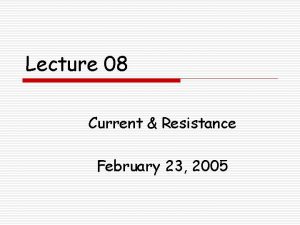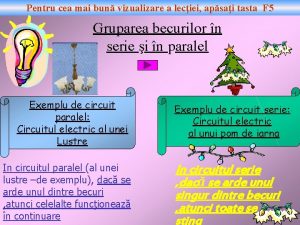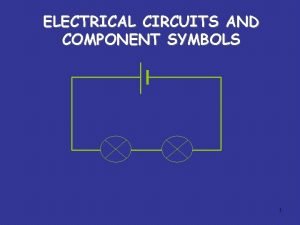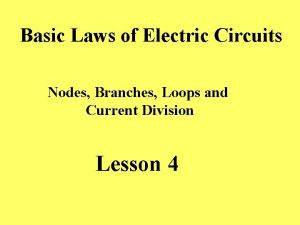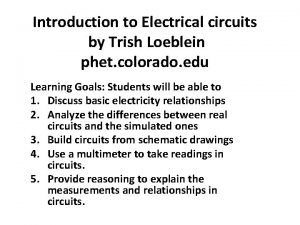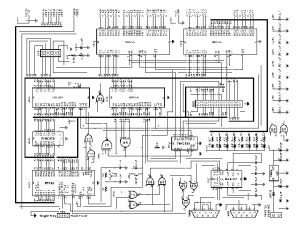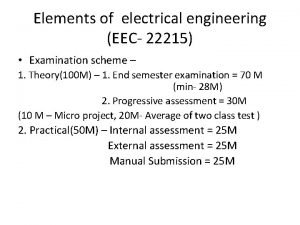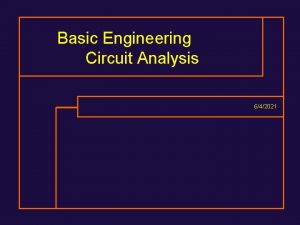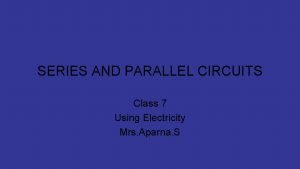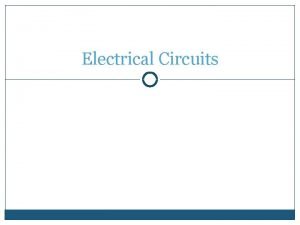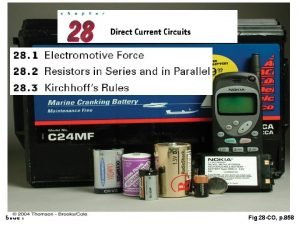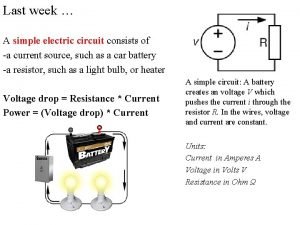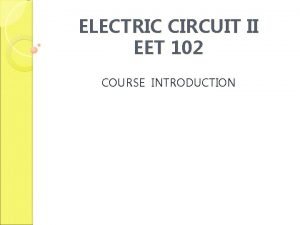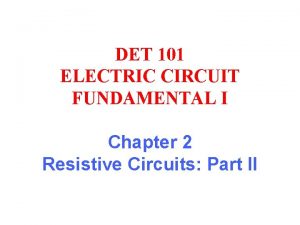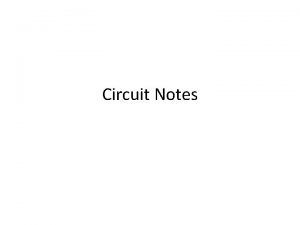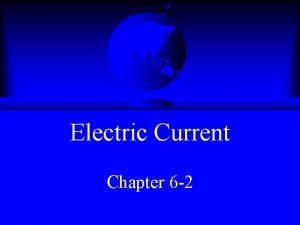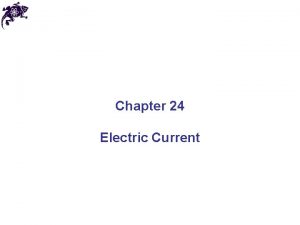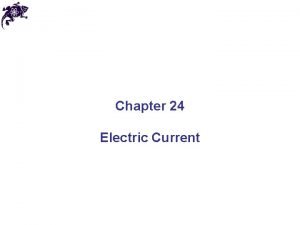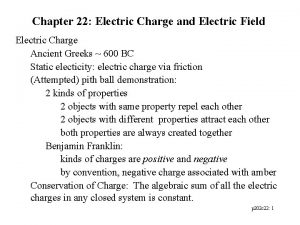DET 101 ELECTRIC CIRCUIT FUNDAMENTAL I Chapter 2







































- Slides: 39

DET 101 ELECTRIC CIRCUIT FUNDAMENTAL I Chapter 2 Part I: Circuit Theorems Dr. Muhammad Solihin Zulkefli Room 11, Block 3, Campus Uni. MAP Pauh Putra

CH 3 PART I: CIRCUIT THEOREMS § Superposition Theorem § Thevenin’s Theorem § Norton’s Theorem § Maximum Power Transfer Theorem

PREVIOUS CHAPTER Series Resistance Current Voltage Parallel

PREVIOUS CHAPTER Series Parallel KVL KCL VDR CDR Law Rule

CH 3 PART I: CIRCUIT THEOREMS § Superposition Theorem § Thevenin’s Theorem § Norton’s Theorem § Maximum Power Transfer Theorem

SUPERPOSITION THEOREM § Some circuits use more than 1 voltage or current source. When multiple sources are used in a circuit, the superposition theorem provides a method for analysis. § The superposition method is a way to determine currents in a circuit with multiple sources by leaving 1 source at a time and replacing the other sources by their internal resistances. § Ideal voltage source: Zero internal resistance § Ideal current source: Infinite internal resistance

SUPERPOSITION THEOREM Example 1:

SUPERPOSITION THEOREM Example 1:

SUPERPOSITION THEOREM Example 1:

SUPERPOSITION THEOREM Example 1:

SUPERPOSITION THEOREM Exercise 1: Find the current through R 2. ANS: I 2 = 50 m. A

SUPERPOSITION THEOREM Exercise 2: Find the current through R 2. ANS: I 2 = 100 m. A

SUPERPOSITION THEOREM Exercise 3: Find the current through R 4 and if Vs= 5 V. ANS: 7 m. A

CH 3 PART I: CIRCUIT THEOREMS § Superposition Theorem § Thevenin’s Theorem § Norton’s Theorem § Maximum Power Transfer Theorem

THEVENIN’S THEOREM § Thevenin’s theorem states that any two-terminal, resistive circuit can be replaced with a simple equivalent circuit when viewed from two output terminals. § The equivalent circuit is:

THEVENIN’S THEOREM § VTH is the open circuit voltage between the two output terminals of a circuit. § RTH is the total resistance appearing between the two output terminals when all sources have been replaced by their internal resistances.

THEVENIN’S THEOREM

THEVENIN’S THEOREM Example 2: Find the Thevenin equivalent circuit between A and B. ANS: VTH = 4. 08 V , RTH = 1410 Ω

THEVENIN’S THEOREM Solution:

THEVENIN’S THEOREM Solution:

THEVENIN’S THEOREM Solution:

THEVENIN’S THEOREM Thevenin equivalency depends on the viewpoint. . !!

THEVENIN’S THEOREM

THEVENIN’S THEOREM

THEVENIN’S THEOREM Exercise 4: a) Determine the Thevenin equivalent circuit viewed from terminals A and C. b) Determine the Thevenin equivalent circuit viewed from terminals B and C. ANS: a) VTH(AC) = 5. 88 V , RTH(AC) = 3. 29 kΩ b) VTH(BC) = 2. 43 V , RTH(BC) = 2. 50 kΩ

CH 3 PART I: CIRCUIT THEOREMS § Superposition Theorem § Thevenin’s Theorem § Norton’s Theorem § Maximum Power Transfer Theorem

NORTON’S THEOREM § Norton’s theorem is a method for simplifying a 2 terminal circuit to an equivalent circuit with only a current source in parallel with a resistor. § Regardless of how complex the original 2 -terminal circuit is, it can always be reduced to this equivalent form.

NORTON’S THEOREM Norton’s Equivalent Current, IN § Norton’s equivalent current (IN) is the short-circuit current between 2 output terminals in a circuit.

NORTON’S THEOREM Norton’s Equivalent Resistance, RN § Norton’s equivalent current (RN) is the total resistance appearing between 2 -output terminals in a given circuit with all sources replaced by their internal resistances.

NORTON’S THEOREM Example 3: Determine IN and RN for the circuit within the area in figure below. ANS: IN = 20. 2 m. A , RN = 123. 5 Ω

NORTON’S THEOREM Solution:

NORTON’S THEOREM Solution:

CH 3 PART I: CIRCUIT THEOREMS § Superposition Theorem § Thevenin’s Theorem § Norton’s Theorem § Maximum Power Transfer Theorem

MAXIMUM POWER TRANSFER § Maximum power transfer is a technique for calculating the maximum value of power that can be delivered to a load, RL. § Maximum power transfer occurs when: RL = RTH (or source resistance, RS) or

MAXIMUM POWER TRANSFER Example 4: The source in circuit below has an internal source resistance of 75 Ω. Determine the load power for each of the following values of load resistance: a) 0 Ω b) 25 Ω c) 50 Ω d) 75 Ω e) 100 Ω f) 125 Ω

MAXIMUM POWER TRANSFER Solution: Use Ohm’s law find the load power, PL. a) For RL = 0 Ω : b) For RL = 25 Ω : and power formula to

MAXIMUM POWER TRANSFER Solution: c) For RL = 50 Ω : d) For RL = 75 Ω :

MAXIMUM POWER TRANSFER Solution: e) For RL = 100 Ω : f) For RL = 125 Ω :

MAXIMUM POWER TRANSFER
 A suitable electric pump in an electric circuit is a
A suitable electric pump in an electric circuit is a Det beskrivende kulturbegreb
Det beskrivende kulturbegreb Det finns bara en gud och det är allah
Det finns bara en gud och det är allah Chapter 21 electric charge and electric field
Chapter 21 electric charge and electric field Chapter 21 electric charge and electric field
Chapter 21 electric charge and electric field Chapter 16 electric charge and electric field
Chapter 16 electric charge and electric field Units of a charge
Units of a charge Chapter 23 electric current circuit happenings
Chapter 23 electric current circuit happenings Expression for electric potential
Expression for electric potential Potential in uniform electric field
Potential in uniform electric field Electric potential energy
Electric potential energy Electric potential is
Electric potential is Electric charges and electric forces lesson outline
Electric charges and electric forces lesson outline Deseneaza pe caiet puncte ca in imagine
Deseneaza pe caiet puncte ca in imagine Symbols for some electric circuit components
Symbols for some electric circuit components Derive ohms law
Derive ohms law What is branch in electrical circuit
What is branch in electrical circuit Membuat desain konstruksi instalasi listrik rumah tangga
Membuat desain konstruksi instalasi listrik rumah tangga Phet circuit construction kit
Phet circuit construction kit Capacitor impedance laplace
Capacitor impedance laplace Electricity water analogy
Electricity water analogy Eec micro project pdf
Eec micro project pdf Electric current in series circuit
Electric current in series circuit Principles of electric circuits
Principles of electric circuits Electric circuit elements
Electric circuit elements Series circuit class 7
Series circuit class 7 Electric current drawing
Electric current drawing Torch electric circuit
Torch electric circuit Circuit
Circuit El circuit electric
El circuit electric Simple electric circuit with label
Simple electric circuit with label Electricity and magnetism
Electricity and magnetism Fusao
Fusao Electric circuit
Electric circuit Voltage in parallel circuit
Voltage in parallel circuit Type of circuits
Type of circuits Phet circuit construction kit
Phet circuit construction kit Current in series
Current in series What is an incomplete circuit
What is an incomplete circuit Short circuit in series and parallel
Short circuit in series and parallel







